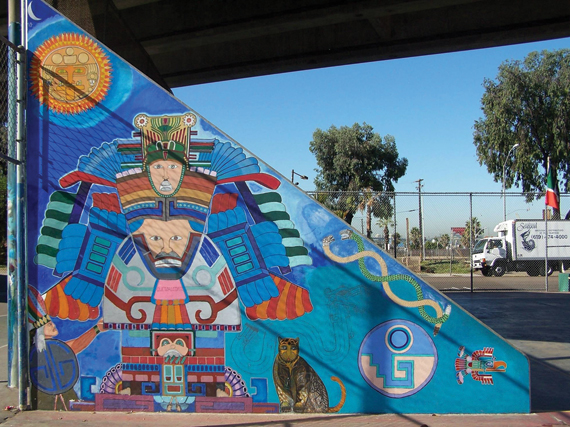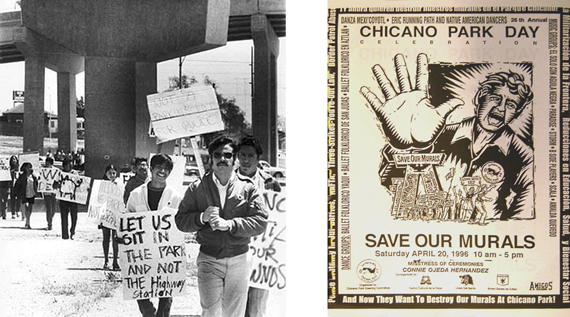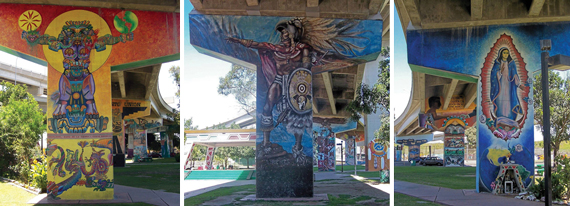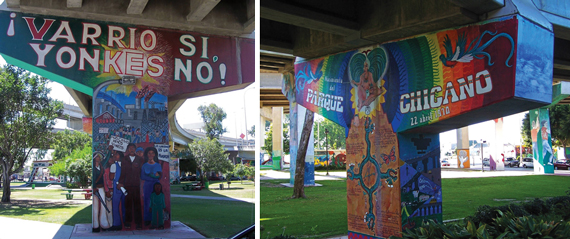 |
|
|
Chicano Parkand its Wondrous MuralsBy Martin D. Rosen It was a cool, clear fall day in 1995 when I first laid eyes on the murals in Chicano Park... and thus my life was changed forever.
The Handball Court mural (1996) was created by Alvaro Millan and guests; this vibrantly colored mural depicts themes of Hispanic heritage and culture from Mesoamerica. Chicano Park is a 7.4-acre park located in Barrio Logan beneath the east-west approach ramps of the San Diego-Coronado Bay Bridge, where SR-75 intersects I-5. The park's main section is bounded by I-5 to the east and National Avenue to the west, with a smaller panhandle section extending from National Avenue to Newton Avenue and flanked to the south by Dewey Street. SR-75, whose east end terminates at I-5 in Barrio Logan, represented a penultimate moment for the local citizenry. The final culminating moment came when it was announced that Caltrans had plans to allow construction of a California Highway Patrol substation under the five eastern ramps. This was viewed as the ultimate insult to a people and community who had long suffered because of prejudice, hatred, and indiscriminately applied zoning laws. The Chicano people rose in protest and formed human chains around heavy equipment ready to grade the land for a substation. They then immediately began to create their park, a "people's park," Chicano Park. They laid sod, started to plant trees, grass, flowers, and create a sacred garden and kiva for ceremonies. Later came the Kiosko (Kiosk), which has become the epicenter for park activities. Then in the early 1970s the first murals were painted. April 22, 1970 is recognized as the "takeover" of the land that was being prepared for the CHP substation. Since 1970, Barrio residents have made extensive use of their new park for social and political events, and annually on the Saturday nearest April 22nd, the community commemorates the founding of Chicano Park with a daylong festival, featuring ethnic foods, dancing, and music. Left Community activists protesting a proposed State plan to build a California Highway Patrol substation under the State Route 75 bridge ramps, circa early 1970, source the San Diego Union. All other photos are by Martin D. Rosen. Right Chicano Park Day poster from April 20, 1996, rallying the community to save the murals from proposed State seismic retrofit activities. 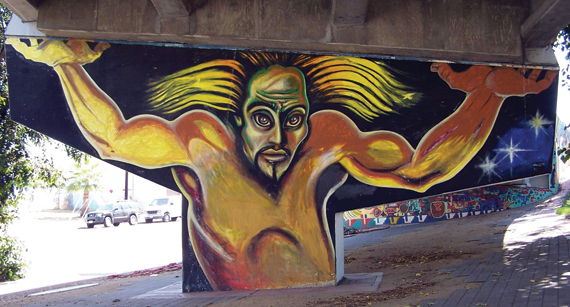
Colossus (1974/1989), metaphorically holding up one of the bridges in Chicano Park, was created by Mario Torero, Mano Lima, and Laurie Manzano.
Chicano Park is distinguished by approximately 40 prominent murals painted on concrete pillars and abutments sited throughout the park. The murals and their iconography depict images of Mexican pre-Columbian gods, myths and legendary icons, botanical elements, animal imagery, the Mexican colonial experience, revolutionary struggles, cultural and spiritual reaffirmation through the arts, Chicano achievements, identity and bicultural duality as symbolized in the search for the "indigenous self," Mexican and Chicano cultural heroes and heroines such as La Adelita, Cesar Chavez, Father Miguel Hidalgo, Che Guevara, Pancho Villa, Emiliano Zapata, and scenes based on contemporary Chicano civil rights history.
Left Coatlicue (1978) represents the Aztec Goddess who gave birth to the moon and stars, among other interpretations; she was created by Susan Yamagata and Michael Schorr. Middle The Aztec Warrior (1978), a classic image, was created by Felipe Adame. Right Virgen de Guadalupe (1978), created by Mario Torero, depicts the Catholic icon of the Virgin Mary. According to the traditional account, the image appeared miraculously on the cloak of Juan Diego, an indigenous peasant, on the hill of Tepeyac near Mexico City on December 12, 1531. A small shrine has been erected at the base of the mural. Unlike the creation of the majority of the murals in the 1970s, the few done in the 1980s and early 1990s were accomplished under the criteria of need, ability, subject matter, and the availability of funding. By early 1984, a group of artists led by Salvador Torres and Mario Torero and members of the Chicano Park Arts Committee began the work of touching up the murals. Due to the fact that mural life is only about 10 years, maintenance is paramount. It was the vision of individual artists and others that initiated the painting of murals on the huge, sterile columns that dominated the park site. They envisioned "a seemingly endless canvas, stretching to the waters of the bay four blocks away," an opportunity to transform and "personalize" the dreary concrete landscape. The artists would crystallize David Siqueiros' description of murals (cf. "Art of Revolution", 1975) that they must be "monumental and realistic," and the Chicano Park murals would be "bigger than life itself." By the late-1970s nearly every major Chicano muralist in California and the Southwest, by invitation and inclination, had participated in the creating of Chicano Park murals.
Left Varrio Si, Yonkes No! (Neighborhood yes, junkyards no!) (1977/1989) was created by Raul Jose Jacquez, Alvaro Millan, Victor Ochoa, and Armando Rodriguez to express community concern for the junkyards that infiltrated the community after freeway construction. Right Nacamiento del Parque Chicano (n.d.) was created by Dolores Serrano-Velez to celebrate the founding of the park on April 22, 1970. In late 1999, through Caltrans I applied for a 1.6 million dollar federal transportation enhancement grant to restore approximately 20 murals in the park. The money has been awarded, the mural restoration guidance manual has been completed, and it is hoped that restoration of these significant works of art can commence soon.
|
2011 - Volume 42MORE FROM THIS ISSUE San Diego's First Chinese Community Chicano Park & its Wondrous Murals Sleeping Porches & Suffragist Banners Most Endangered List of Historic Resources People In Preservation Winners Preservation Community
Recent Acquisitions
DOWNLOAD full magazine as pdf (11.3mb) |
Mailing - PO Box 80788 · San Diego CA 92138 | Offices - 3525 Seventh Avenue · San Diego CA 92103
|
